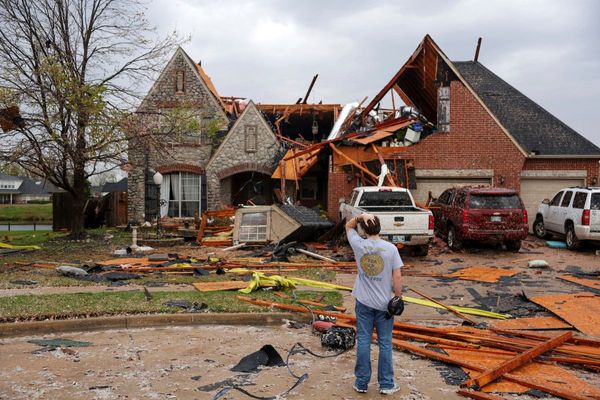
Head down, head up, now to one side, then to the other. Now straight ahead. Frank Auerbach’s charcoal heads lean in and swerve away. I don’t think he ever told anyone how to sit or strike up a pose – and he never, most importantly, told any of his models how to be. They were busy doing nothing throughout the sessions that went on week after week, month after month. When he scribbled a month and a year somewhere near the edge of one drawing, it looks like he’s sending up a cheer in a childish hand that finally he’s done.
Drawn and erased, redrawn and then erased again, Frank Auerbach’s heads emerge from multiple attempts and successive failures. Failing better, as Samuel Beckett had it, Auerbach eventually made good. Much is made of the effort and what’s been called the hard-won image in Auerbach’s work, whether in painting or in drawing. What would it be like, I’ve often wondered, if he got it right first time? I don’t think Auerbach believes in miracles, though I do think that mystery – and the mysterious connection between the artist and the sitter, or of one human being in front of another – has more than intrigued him throughout his long career.

Here these people are, and we think we can hear their minds ticking away, which is also part of his achievement, especially when the drawings are such build-ups of the cursory and the worried over, the impetuous and the studied, the lunged-at and tender, all these attempts at identification. Auerbach is here, too, an inescapable presence even when he’s the one making the drawing rather than the one who is in it. His drawings are always all about presence and being, and the multiplicity and richness of encounter, the artist and the model, the artist and the drawing, us and them. The only gaze we meet is the artist’s own in a couple of self-portraits, but even then he’s looking right through us or towards something else that we can’t see.
The Courtauld has bought together 17 charcoal portraits made between 1956 and 1962. There are only six subjects – three of painter Leon Kossoff, seven of Stella West (“EOW”), whom he met while both were acting in a play by Peter Ustinov, two of Julia Wolstenholme, who later became his wife, three of his cousin Gerda Boehm, Helen Gillespie and two self-portraits. All are drawn in charcoal, sometimes with a little bit of white, blue or red chalk on roughly imperial sized sheets of paper. One has been worked over in oil paint, and mounted on a sheet of hardboard, and almost all the others have been through innumerable scrapes – the paper so abraded by his eraser that its surface is scuffed, peeled, worn through, torn, patched, repatched (sometimes with a different sort of paper), wrinkled, worn smooth and sometimes almost burnished by his repeatedly rubbing on and taking off the charcoal, often working with his fingers or a rag but often using a hard typewriter rubber that would frequently take the surface right off a piece of paper and eventually gouge right through it.
Quite soon Auerbach started gluing two sheets of paper together, to double its thickness and make it more resilient. He still ends up having to make running repairs to give himself a surface and keep the drawings workable, even when the charcoal dust is building up along the contours of the patches like irrefutable forensics evidence and the eraser has nibbled at the edges which have gone all friable and beginning to look like the mice have been at them.
Some artists might make a fetish of this kind of hard labour and paper abuse, and it can easily become a tedious mannerism. Auerbach himself said that he just got on with it, and was interested to see what this curious object was that he found himself making. “It seemed expressive of the situation,” he said, and insisted he wasn’t play-acting, but had the feeling that the drawings had “risen out of the battle into being an image that stands up for itself”.
In Auerbach’s drawings there is something almost magnificent about the way these presences, friends and lovers and people close to him rear up from the ruined sheets, and how things seem to cohere with a kind of finality. At the same time, in both Auerbach’s paintings and drawing, there is always a sense that whatever final state has been arrived at remains provisional and precarious. In short, this keeps them alive.

Looking at photographs of works already installed in exhibitions would sometimes spur the young artist to ask for the paintings and drawings to be sent back to him so he could work on them some more. And for all their erasures and revisions, these drawings are cumulative. The commas and vectors and juddering lines, the swipes of light across a forehead or a cheekbone, the light that flattens a face and the layered blacks that sculpt caves underneath the overhang of the brow, the keel of the nose cleaving the air, the swerves across the crown of the head that make us think of a scarf or maybe even a hat from Rembrandt’s dressing-up box, the rounded neckline that begs a renaissance tunic, the marks that claw at necks and shoulders like an animal’s been in there, the quick black lines like a teacher’s adjustment to show how it’s done or a censor’s mark-up for a demolition job, all add up to something.
They’re all signs of life, after all, against the odds. It is difficult to look at all the damage and dust without being reminded that Auerbach came to Britain on the Kindertransport, and that his family died in the Holocaust, and that his cousin Gerda and her husband escaped Berlin and came to London in 1938, in the nick of time. When Auerbach made these drawings, London was still full of war damage and was black with soot that had been accumulating for centuries. His drawings reflect a texture of feelings as much of places.
“At the end comes a certain improvisation,” the artist has said. “I get the courage to do the improvisation only at the end.” It is as if all those earlier weeks and months were rehearsals, a kind of getting into character for the final performance. I think he always steered away from the glib and didn’t want to be seen as facile – not that that was ever much of a danger. It is quite clear that Auerbach’s work is performative, but it is not a trick. Or maybe he wants you to think it isn’t a trick, or a bravura performance. Nor do I think we are supposed to get all mawkish about the ruins and destruction that went into these drawings, nor to applaud all the effort and paint that has gone into his paintings.
Artists are often method actors who get subsumed in the roles they have invented for themselves. Marcel Duchamp said that that was the artist’s greatest invention. It is a place to make work from. Filling just two rooms, Auerbach’s drawings are interspersed with a few paintings of the period, of the same subjects, the same heads. The drawings are more than instructive, and somehow have more time in them than the paintings. I have never liked his work as much as I do today.
• Frank Auerbach: The Charcoal Heads is at The Courtauld Institute, London, until 27 May







